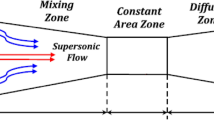Abstract
A two-dimensional steady state model was developed and solved numerically to predict the performance of evaporative condensing regenerator. Two-dimensional parameter distributions of air, solution and refrigerant were calculated by the mathematical model. The solution content first increases and then decreases along the solution flow direction. At y/H r=0.98 (where H r is the height of regenerator), air humidity increases from 1.99% to 2.348% firstly and then decreases. The experimental results were used to validate mathematical model. It is indicated that the simulation results agree with experimental data well. The results not only show that the mathematical model can be used to predict the performance of regenerator, but also has great value in the design and improvement of evaporative condensing regenerator.
Similar content being viewed by others
References
HWANG Y, REINHARD R, WILLIAM K. An experimental evaluation of a residential-sized evaporatively cooled condenser [J]. International Journal of Refrigeration, 2001, 24: 238–249.
BILAL A. QURESHI S, ZUBAIR M. A comprehensive design and rating study of evaporative coolers and condensers (Part I): Performance evaluation [J]. International Journal of Refrigeration, 2006, 29: 645–658.
ALA H. Performance investigation of plain and finned tube evaporatively cooled heat exchangers [J]. Applied Thermal Engineering, 2003, 23: 325–340.
LIU Xiao-hua, JIANG Yi. Heat and mass transfer model of cross flow liquid desiccant air dehumidifier/regenerator [J]. Energy Conversion and Management, 2007, 48: 546–554.
GANDHIDASAN P. Quick performance prediction of liquid desiccant regeneration in a packed bed [J]. Solar Energy, 2005, 79: 47–55.
ARSHAD Y K. Cooling and dehumidification performance analysis of internally-cooled liquid desiccant absorbers [J]. Applied Thermal Engineering, 1998, 18: 265–281.
ABDUL-WAHAB S A, ZURIGAT Y H, ABU-ARABI M K. Predictions of moisture removal rate and dehumidification effectiveness for structured liquid desiccant air dehumidifier [J]. Energy, 2004, 29: 19–34.
REN Chen-qin, JIANG Yi, ZHANG Yian-pin. Simplified analysis of coupled heat and mass transfer processes in packed bed liquid desiccant-air contact system [J]. Solar Energy, 2006, 80: 121–131.
ANI F N, BADAWI E M, KANNAN K S. The effect of absorber packing height on the performance of a hybrid liquid desiccant system [J]. Renewable Energy, 2005, 30: 2247–2256.
LIU X H, GENG K C, LIN B R. Combined cogeneration and liquid-desiccant system applied in a demonstration building [J]. Energy and Buildings, 2004, 36(9): 945–953.
YIN Yong-gao, ZHANG Xiao-song, WANG Geng. Experimental study on a new internally cooled/heated dehumidifier/regenerator of liquid desiccant systems [J]. International Journal of Refrigeration, 2008, 31(5): 857–866.
THOSAPON K, SURAPONG C, KURNAR B S. An experimental study of a solar-regenerated liquid desiccant ventilation pre-conditioning system [J]. Solar Energy, 2009, 83: 920–933.
LOWENSTEIN A. Review of liquid desiccant technology for HVAC applications [J]. HVAC & R Research, 2008, 14(6): 819–839.
LONGO G A, GASPARELLA A. Experimental analysis on desiccant regeneration in a packed column with structured and random packing [J]. Solar Energy, 2009, 83: 511–521.
SULTAN G I, MAHMED A. The effect of inlet parameters on the performance of packed tower-regenerator [J]. Renewable Energy, 2002, 26: 271–283.
ESAM E. Performance study on a structured packed liquid desiccant regenerator [J]. Solar Energy, 2006, 80: 1624–1631.
Author information
Authors and Affiliations
Corresponding author
Additional information
Foundation item: Project(PHR201007127) supported by Academic Human Resources Development Fund of Institutions of Higher Learning under the Jurisdiction of Beijing Municipality, China; Project(bsbe2010-05) supported by the Opening Funds of State Key Laboratory of Building Safety and Built Environment, China; Project supported by the Doctoral Startup Foundation of Beijing University of Civil Engineering and Architecture, China
Rights and permissions
About this article
Cite this article
Niu, Rp., You, Sj. Modeling and numerical analysis of evaporative condensing regenerator. J. Cent. South Univ. Technol. 19, 824–828 (2012). https://doi.org/10.1007/s11771-012-1078-2
Received:
Accepted:
Published:
Issue Date:
DOI: https://doi.org/10.1007/s11771-012-1078-2




